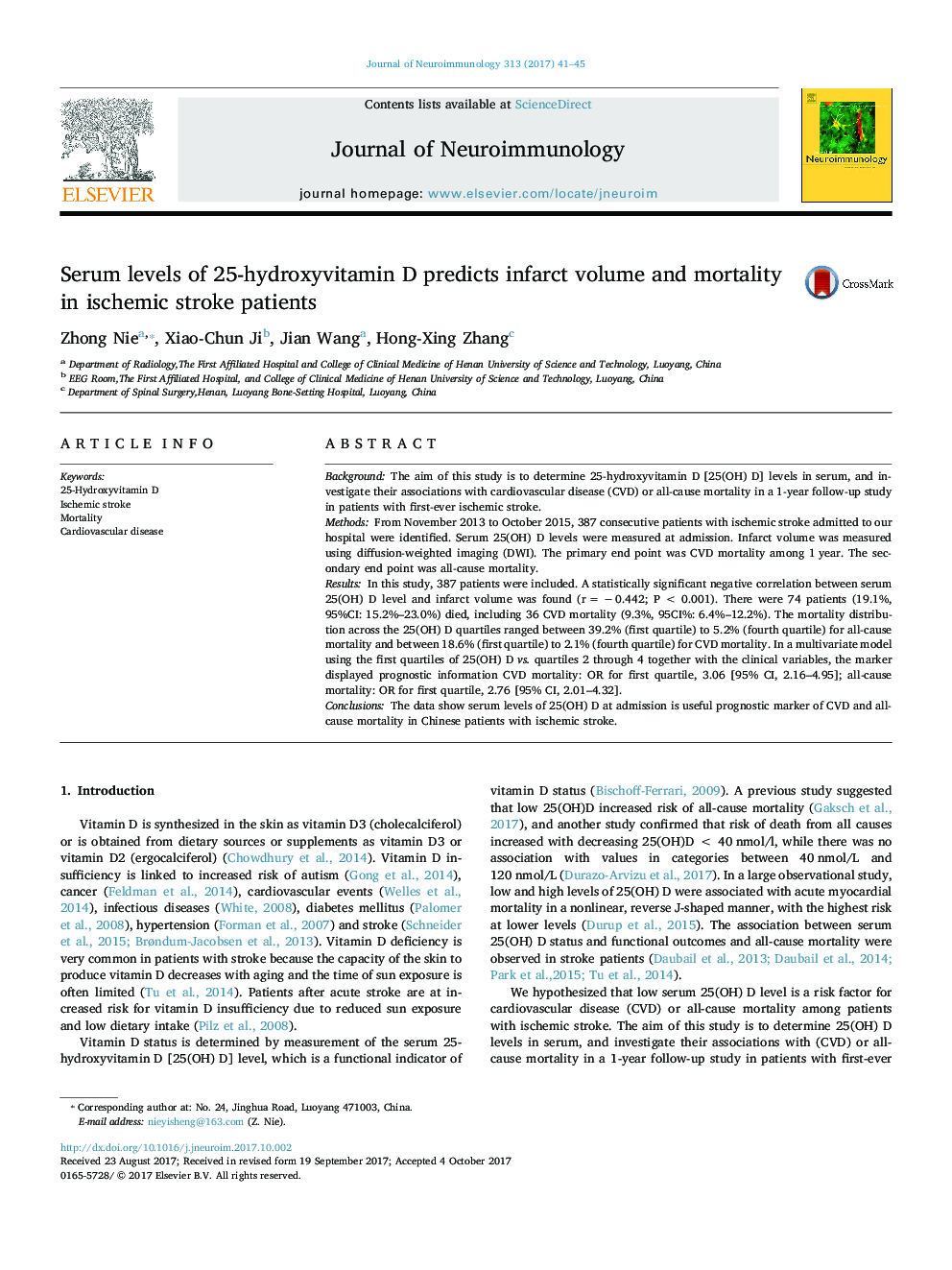| Article ID | Journal | Published Year | Pages | File Type |
|---|---|---|---|---|
| 5630098 | Journal of Neuroimmunology | 2017 | 5 Pages |
â¢25(OH) D level is a risk factor for mortality among ischemic stroke.â¢Using the first quartiles of 25(OH) D vs. Q2-Q4, 25(OH) D displayed prognostic information.â¢25(OH) D is useful prognostic marker of CVD and all-cause mortality in ischemic stroke.â¢The effect of vitamin D substitution on mortality in stroke needs further verified.
BackgroundThe aim of this study is to determine 25-hydroxyvitamin D [25(OH) D] levels in serum, and investigate their associations with cardiovascular disease (CVD) or all-cause mortality in a 1-year follow-up study in patients with first-ever ischemic stroke.MethodsFrom November 2013 to October 2015, 387 consecutive patients with ischemic stroke admitted to our hospital were identified. Serum 25(OH) D levels were measured at admission. Infarct volume was measured using diffusion-weighted imaging (DWI). The primary end point was CVD mortality among 1 year. The secondary end point was all-cause mortality.ResultsIn this study, 387 patients were included. A statistically significant negative correlation between serum 25(OH) D level and infarct volume was found (r = â 0.442; P < 0.001). There were 74 patients (19.1%, 95%CI: 15.2%-23.0%) died, including 36 CVD mortality (9.3%, 95CI%: 6.4%-12.2%). The mortality distribution across the 25(OH) D quartiles ranged between 39.2% (first quartile) to 5.2% (fourth quartile) for all-cause mortality and between 18.6% (first quartile) to 2.1% (fourth quartile) for CVD mortality. In a multivariate model using the first quartiles of 25(OH) D vs. quartiles 2 through 4 together with the clinical variables, the marker displayed prognostic information CVD mortality: OR for first quartile, 3.06 [95% CI, 2.16-4.95]; all-cause mortality: OR for first quartile, 2.76 [95% CI, 2.01-4.32].ConclusionsThe data show serum levels of 25(OH) D at admission is useful prognostic marker of CVD and all-cause mortality in Chinese patients with ischemic stroke.
Graphical abstractThe association between serum 25-hydroxyvitamin D [25(OH) D] status and functional outcomes and all-cause mortality were observed in stroke patients. In this study, we determine levels 25(OH) D in serum, and investigate their associations with cardiovascular disease (CVD) or all-cause mortality in a 1-year follow-up study in 387 patients with first-ever ischemic stroke. Serum 25(OH) D levels were measured at admission. The primary end point was CVD mortality among 1Â year. The secondary end point was all-cause mortality. There were 74 patients (19.1%, 95%CI: 15.2%-23.0%) died, including 36 CVD mortality (9.3%, 95CI%: 6.4%-12.2%). The mortality distribution across the 25(OH) D quartiles ranged between 39.2% (first quartile) to 5.2% (fourth quartile) for all-cause mortality and between 18.6% (first quartile) to 2.1% (fourth quartile) for CVD mortality, Figure. In a multivariate model using the first quartiles of 25(OH) D vs. quartiles 2 through 4 together with the clinical variables, the marker displayed prognostic information CVD mortality: OR for first quartile, 3.06 [95% CI, 2.16-4.95]; all-cause mortality: OR for first quartile, 2.76 [95% CI, 2.01-4.32]. The data show serum levels of 25(OH) D at admission is useful prognostic marker of CVD and all-cause mortality in Chinese patients with ischemic stroke.Download high-res image (61KB)Download full-size image
